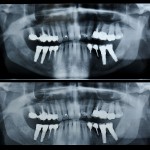
Dental implants have become a common replacement for missing teeth with studies regularly demonstrating 5-year survival rates in the 90-95% range. It is however important to distinguish between survival and treatment success. The incidence of technical and biological complications with implant treatment is common with peri-implant disease being most relevant biological complication. Mucositis and peri-implantitis are the two conditions described with peri-implantitis causing both soft and hard tissue loss resulting in bone loss, pocketing and tissue inflammation.
The main aim of this review was to estimate the overall prevalence of peri-implantitis.
Methods
A protocol for the review was registered with PROSPERO. Searches were conducted in the Cochrane Library, Medline/PubMed, Science Direct and Web of Science databases from 1 December 2005 to 31 December 2021. Original studies describing the diagnosis of peri-implantitis and observational and experimental studies (cross-sectional, longitudinal, cohort or randomized controlled trial) with original prevalence data published in peer reviewed journals published in English were considered. Three reviewers selected studies and assessed quality using the Cochrane risk of bias tool. Studies considered to be high risk were excluded. Data was extracted by 3 reviewers with studies being grouped into 4 groups based on diagnostic criteria; Group 1 -Bleeding on probing [BOP], pocket depth [PD]≥6 mm and Loss of supporting bone [BL]≥3 mm) Group 2 (BOP, PD≥6 mm and BL≥2 mm), Group 3 (Progressive Bone Loss), and Group 4 (Other Criteria).
Results
- 57 studies (18 cross-sectional,18 longitudinal, 17 cohort studies, 3 RCTs and 1 case-control) were included.
- Mean peri-implantitis prevalence at patient and implant level overall and for each of the 4 diagnostic groups is shown in the table below.
| Group | Patient-level prevalence (95%CI) | implant-level prevalence (95%CI) |
| 1 | 16.4 % (0.9 to 31.89%) | 12.12% (2.96 to 21.29%) |
| 2 | 20.67 % (15.89 to 25.44%) | 12.65% (8.98 to 16.31%) |
| 3 | 14.68% (4.13 to 25.23%) | 12.04% (4.71 to 19.37%) |
| 4 | 23.94% (1.91 to 45.98%) | 13.21% (0.45 to 25.98%) |
| Overall | 19.53 % (12.87 to 26.19%) | 12.53% (11.67 to 13.39%) |
- Random and fixed effects meta-analyses for prevalence of peri-implantitis are shown in table below
| Meta-analysis | Patient-level prevalence (95%CI) | implant-level prevalence (95%CI) |
| Random effects | 20% (16.6 to 23.7%) | 11.5% (8 to 15.4%) |
| Fixed effects | 19.6% (18.4 to 20.8%) | 12.3% (11.7–12.9%) |
Conclusions
The authors concluded: –
Within the limitations of this study, it can be concluded that prevalence of peri-implantitis, using 4 different definitions, was found to be approximately 20% at patient-level and 11.5% at implant-level. The results indicate that the identification of the peri-implantitis diagnostic criteria is essential to achieve greater accuracy in the disease classification, and for correct estimation of the true prevalence value of peri-implantitis.
Comments
The authors have searched a good range of databases but have limited the time frame and inclusion to English language publications which is likely to have excluded some relevant studies. It could be argued that the time frame limitation means that the findings are more representative of the current clinical environment. Although it may be interesting to understand if there have been any changes in prevalence over time. One of the challenges with this review is the variation in the diagnostic criteria employed in the included studies. The authors have tried to address this by assigning the included studies to 4 separate groups as well as providing an overall prevalence that included all the studies. This diagnostic heterogeneity needs to be taken into account when interpreting the findings as does the fact that most of the studies used data from convenience samples. The overall patient level prevalence of 20% (95%CI; 16.6 to 23.7%) derived from the random effects meta-analysis provides a pragmatic estimate in the circumstances and is similar to the 22% (95%CI; 14 to 30%) found in an earlier review by Derks and Tomasi (Dental Elf – 15th Apr 2015) .However future studies need to be prospective, well designed and reported and use a common agreed set of diagnostic criteria.
Links
Primary Paper
Diaz P, Gonzalo E, Villagra LJG, Miegimolle B, Suarez MJ. What is the prevalence of peri-implantitis? A systematic review and meta-analysis. BMC Oral Health. 2022 Oct 19;22(1):449. doi: 10.1186/s12903-022-02493-8. PMID: 36261829.
Other references
Dental Elf – 15th Apr 2015
